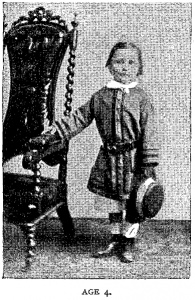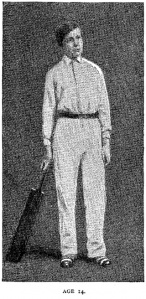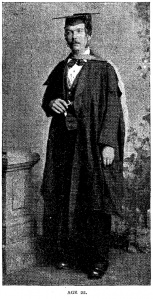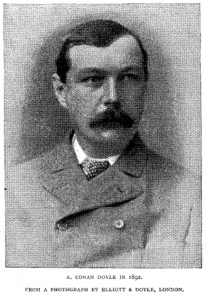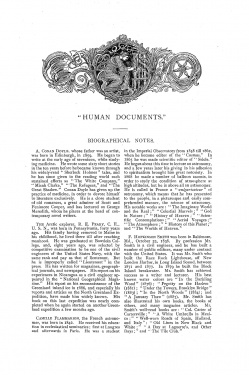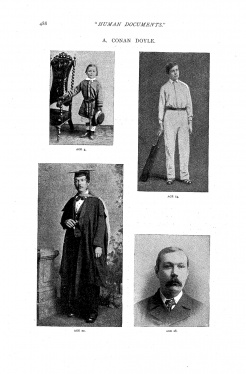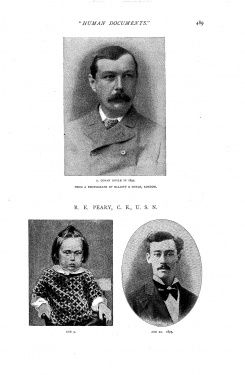Human Documents. Biographical Notes
Human Documents. Biographical Notes is an article published in the McClure's Magazine in november 1893.
The article is a presentation of several known personnalities including Arthur Conan Doyle, the American arctic explorer R. E. Peary, the French astronomer Camille Flammarion and the American artist F. Hopkinson Smith.
Photos
Here are only the 5 photos of Arthur Conan Doyle.
- Photos in the McClure's Magazine (march 1894)
-
Age 4.
-
Age 14.
-
Age 22.
-
Age 28.
-
A. Conan Doyle in 1892.
From a photograph by Elliott & Doyle, London.
Human Documents. Biographical Notes
A. CONAN DOYLE, whose father was an artist, was born in Edinburgh, in 1859. He began to write at the early age of seventeen, while studying medicine. He wrote some sixty short stories in the ten years before he became known through his widely-read "Sherlock Holmes" tales, and he has since given to the reading world such sustained efforts as "The White Company," "Micah Clarke," "The Refugees, and "The Great Shadow." Conan Doyle has given up the practice of medicine, in order to devote himself to literature exclusively. He is a dose student of old romances, a great admirer of Scott and Fenimore Cooper, and has lectured on George Meredith, whom he places at the head of contemporary novel writers.
The Arctic explorer, R. E. PEARY, C.E., U.S.N., was born in Pennsylvania, forty years ago. His family having removed to Maine in his childhood, he lived there till after reaching manhood. He was graduated at Bowdoin College, and, eight years ago, was selected by competitive examination to be one of the civil engineers of the United States Navy, with the same rank and pay as that of lieutenant. But he is improperly called "Lieutenant" in the press. He has written for magazines, geographical journals, and newspapers. His report on his experiences in Nicaragua as a civil engineer appeared in the "National Geographical Magazine." His report on his reconnoissance of the Greenland inland ice in 1886, and especially his reports and articles on the North Greenland Expedition, have made him widely known. His book on this last expedition was nearly completed when he again started on another Greenland expedition a few months ago.
CAMILLE FLAMMARION, the French astronomer, was been in 1845. He received his education in ecclesiastical seminaries ; first at Langres and afterwards in Paris. He was a student in the Imperial Observatory from 1858 till 1862, when he became editor of the "Cosmos." In 1865 he was made scientific editor of "Siècle." He began about this time to lecture on astronomy, and a few years later his giving in his adhesion to spiritualism brought him great notoriety. In 1868 he made a number of balloon ascents, in order to study the condition of atmosphere at high altitudes, but he is above all an astronomer. He is called in France a "vulgarisateur" of astronomy, which means that he has presented to the people, in a picturesque and easily comprehended manner, the science of astronomy. His notable works are : "The Imaginary World and the Real;" "Celestial Marvels;" "God in Nature;" "History of Heaven;" "Scientific Contemplations;" "Aerial Voyages;" "The Atmosphere;" "History of this Planet;" and "The Worlds of Heaven."
F. HOPKINSON SMITH was born in Baltimore, Md., October 23, 1838. By profession Mr. Smith is a civil engineer, and he has built a number of public edifices, many under contract with the United States. It was Mr. Smith who built the Race Rock Lighthouse, off New London Harbor, in Long Island Sound, between 1871 and 1877. In 1879 he built the Block Island breakwater. Mr. Smith has achieved success as a writer and lecturer. His best known water colors are "In the Darkling Wood" (1876) ; "Pegotty on the Harlem" (1881) ; "Under the Towers, Brooklyn Bridge" (1883) ; "In the North Woods" (1884) ; and "A January Thaw" (1887). Mr. Smith has also illustrated his own books, the books of others, and many magazine articles. Mr. Smith's well-read books are "Col. Carter of Cartersville;" "A White Umbrella in Mexico" "Well-worn Roads of Spain, Holland, and Italy" ; "Old Lines in New Black and White;" "A Day at Laguerre's, and Other Days;" and "The Tile Club."
-
McClure's Magazine
(november 1893, p. 487). -
McClure's Magazine
(november 1893, p. 488). -
McClure's Magazine
(november 1893, p. 489).
